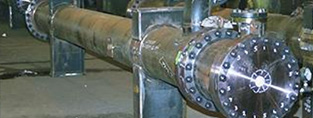
- (03) 5909 8218
- enquiry@fusionweld.com.au
What is Shell & Tube Heat Exchanger?
October 14, 2016

Examples of shell and tube heat exchangers exist in every industry, but there's no need to tour a dirty plant room in search of one of these special vessels, for even the humblest residence has access to one of these essential energy transmitters.
What is a Shell and Tube Heat Exchanger?
Unlike the large pressurized vessels we've described in other articles, this intelligently engineered container doesn't just store condensed fluids. Instead, this active mechanism is designed to swap heat between one liquid medium and a second fluid. That doesn't sound like much work, but this clever design accomplishes its heat exchanging magic without mixing the two mediums. This is accomplished by placing one medium in the shell and the second in a tube stack that's also contained within the shell.
Designing Heat Salvaging Vessels
The petroleum industry uses shell and tube heat exchangers for several purposes, but thermal energy conservation rates highly on the usage chart. The exchanging mechanism leverages energy from wasted processes and redirects that energy so that key areas of a hydrocarbon-rich facility can be cooled or heated by the ancillary interfacing aptitude of what's basically a non-mixing energy conservation aid. Of course, what's been described so far is a fundamental design. Working vessels use headers to deliver the disassociated fluids, at which point a complex series of mechanical baffles enhances the distribution of the shell flow so that peak areal coverage is achieved between the two discrete mediums.
Exploring the Applications of an Active Vessel
Central heating furnaces use an elementary form of heat exchange, with a flame of natural gas or liquid fuel taking the place of the tube stack. More complex heating configurations recruit the tube stack when several energy states are present in the processing system. Superheated steam may flow in the shell side, for example, but the temperature difference created by the secondary fluid will result only in enough energy to heat the radiators in a large apartment complex. Meanwhile, on returning to our petroleum models, the diversity of the format makes many usages possible. The pressure-conscious design can handle the heated exhaust fumes of a post-catalyzing process within a large oil refinery, thus scavenging energy that can be applied elsewhere, or it can even reverse function to operate as a cooling aid.
A shell and tube heat exchanger is an essential part of a heat differential setup within a fluid-based system that requires an energy management feature, for it uses a pressure vessel and a tube stack to swap energy without those two energy sources ever making contact.
Contact Details
Fusion - Weld Engineering Pty Ltd
ABN 98 068 987619
1865 Frankston Flinders Road,
Hastings, VIC 3915
Ph: (03) 5909 8218
Optimized by NetwizardSEO.com.au
Recent Posts
- Compressed Hydrogen Storage Vessels: Material Selection, Design & Australian Standards
- Welding QA/QC in Oil & Gas Pressure Vessel Fabrication – Ensuring Code Compliance
- AS1210 vs ASME VIII Pressure Vessel Code: Key Differences for Australian Projects
- Mitigating Hydrogen-Induced Cracking in Pressure Vessels: Engineering and Material Strategies
- Storage Tank Solutions Australia: Field-Erected, Prefabricated & Self-Bunded Explained
- Reducing Environmental Risks: Self-Bunded Tanks in Australian Oil & Gas Operations
- Precision in Production: How Pressure Vessels Are Manufactured for Industrial Safety
- Shell & Tube Heat Exchangers: Improve Thermal Control & Energy Recovery in Petrochemical & Pharmaceutical Plants
- In-Service Inspection for Compressed Air Receivers for Power Plant Shutdown Prevention
- Power Plant Pipe Spooling Fabrication – Get Rapid, Code-Compliant Spools Ready for Installation
- Field Erected Tanks: Safe, Reliable On-Site Fuel Storage Solutions in Australia
- Custom Pressure Vessel Fabrication for Flammable Gases
Posts 2025
- Compressed Hydrogen Storage Vessels: Material Selection, Design & Australian Standards
- Welding QA/QC in Oil & Gas Pressure Vessel Fabrication – Ensuring Code Compliance
- View all articles…
Posts 2024
- Large Process Vessels: Optimising the Design for Maximum Efficiency [2025]
- Pressure Equipment Management System Installation: Detect Equipment Faults Early
- View all articles…
Posts 2023
- Pressure Piping System Inspection: A Gift of Safety for the Holidays
- Deaerator Inspections by Fusion-Weld Engineering and How They Reduce System Downtime
- View all articles…
Posts 2022
- How Fusion Weld Keeps Up With AS-NZS ISO 9001:2008 Standard
- Boiler Equipment Safety Inspection During the Summer Season
- View all articles…
Posts 2021
- Avoid These Factors and Practices that Contribute to Sealing Damage in Pressure Vessels
- Do's And Don'ts Of Industrial Boiler Inspection And Maintenance From Fusion-Weld
- View all articles…
Posts 2020
- What are the Risks and Hazards Involved in Pressure Vessel Equipment?
- How to Know if Your Pressure Equipment Needs Repair or Replacement?
- View all articles…
Posts 2019
- Factors that Contribute to Pressure Vessel Failure
- Pressure Vessel Regulations in Australia: What are the Mandatory Requirements?
- View all articles…
Posts 2018
- Pros and Cons of Spherical vs. Cylindrical Pressure Vessels
- What are the Different Hazard Levels in Pressure Vessels?
- View all articles…
Posts 2017
- Transportable Pressure Vessels: The Importance of Inspection and Safety Checks
- Fracture Mechanics and Stress Analysis of Cracks in Pressure Vessels
- View all articles…
Posts 2016
Posts 2015
- What Are Deaerators & Feedwater Vessels?
- Precautions and Safety for Compressed Air Receiver Vessels
- View all articles…
Posts 2014
- Demonstrating In-process Inspection Procedures
- Static Grounding Practices and Standards
- View all articles…